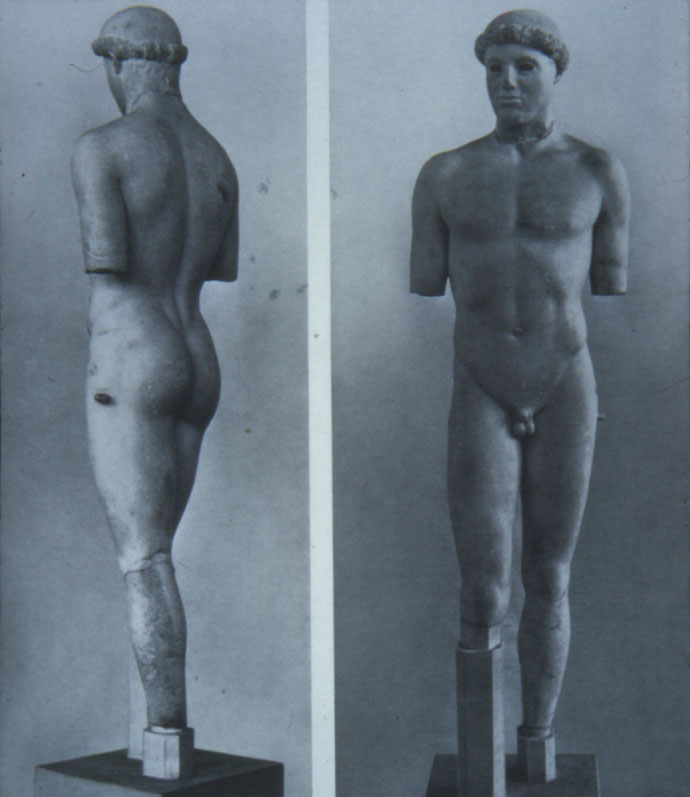| rdfs:comment
| - L'Efeb de Críties, també conegut com a Noi de Críties, és una escultura d'un jove atleta que data de l'any 480aC i que no té un autor conegut, encara que se li atribueix de vegades a Críties, artista atenès de l'antiga Grècia, per la semblança del cap als caps de les seves escultures i perquè aquesta obra porta el seu nom. (ca)
- Ο Παις του Κριτίου είναι αριστουργηματικό έργο αρχαίας γλυπτικής τέχνης. Φιλοξενείται στο Μουσείο της Ακρόπολης, ενώ αντίγραφό του εκτίθεται και στο . (el)
- El Efebo de Kritios, también conocido como Muchacho de Kritios, es una escultura de un joven atleta que data del año 480 a. C. y que no tiene un autor conocido, aunque se le atribuye a veces a Kritios, artista ateniense de la Antigua Grecia, por el parecido de la cabeza a las cabezas de sus esculturas y porque esta obra lleva su nombre. (es)
- Der sogenannte Kritios-Knabe wurde in mehreren Teilen 1866 und 1888 bei Ausgrabungen auf der Akropolis in Athen gefunden. Die Skulptur wurde früher der Werkstatt der Bildhauer Kritios und Nesiotes zugeschrieben, die auch die Skulpturengruppe der Tyrannenmörder geschaffen haben. Aus dieser Zeit stammt ihr wissenschaftlicher Name. Die 1,17 Meter hohe Marmorstatue befindet sich unter der Inventarnummer 698 im Akropolismuseum von Athen. (de)
- Kritiosen mutil gaztea edo Kritiosen efeboa K.a. 480. urteko mutil gazte bat irudikatzen duen eskultura da. Ez du egile ezagunik, nahiz eta artista atenastarrak eginiko eskulturen buruek eskultura honen buruarekin duten antzekotasunagatik eta eskulturaren izenagatik, Kritios artista atenastarrari egozten zaion eskultura honen egiletza. (eu)
- L’éphèbe de Critios est une statue grecque antique en marbre de Paros découverte sur l'acropole d'Athènes, attribuée au sculpteur Critios et datée des environs de 480 av. J.-C. (fr)
- The marble Kritios Boy or Kritian Boy belongs to the Early Classical period of ancient Greek sculpture. It is the first statue from classical antiquity known to use contrapposto; Kenneth Clark called it "the first beautiful nude in art" It is possible, even likely, that earlier bronze statues had used the technique, but if they did, they have not survived and Susan Woodford has speculated that the statue is a copy of a bronze original. The Kritios Boy is thus named because it is attributed, on slender evidence, to Kritios, who worked together with Nesiotes (sculptors of Harmodius and Aristogeiton) or their school, from around 480 BC. As currently mounted, the statue is considerably smaller than life-size at 117 cm (3 ft 10 ins), including the supports that replace the missing feet. (en)
- 克雷提奧斯的少年(Kritios Boy)是一尊古希臘雕塑。這座雕塑是古典時代已知的第一座使用對立式平衡的雕塑。肯尼斯·克拉克評價這座雕塑是「藝術界第一尊美麗的裸體」。 (zh)
- La statua frequentemente denominata Efebo di Crizio è un'opera in marmo alta 86 cm, realizzata e dedicata sull'acropoli di Atene intorno agli anni ottanta o settanta del V secolo a.C.; non è possibile allo stato delle conoscenze datare con sicurezza l'opera anteriormente o posteriormente al sacco perpetrato dai Persiani ai danni della cittadella nel 480-479 a.C. L'opera, fin dal suo rinvenimento, è stata accostata, su base stilistica, alla bottega di Crizio e Nesiote, e la sua importanza consiste nell'essere la più antica testimonianza (la sua posa non è attestata prima del 480 a.C.) del passaggio stilistico che determinò l'abbandono, nella scultura greca, degli stilemi arcaici in favore di una struttura maggiormente organica della figura umana, convenzionalmente indicato nel passaggio dal (it)
- Efeb Kritiosa – marmurowa rzeźba grecka z okresu archaicznego. Znajduje się w zbiorach Muzeum Akropolu w Atenach. Jej autorstwo przypisywane jest rzeźbiarzowi Kritiosowi. Przedstawiająca nagiego młodzieńca rzeźba wykonana została z marmuru paryjskiego i mierzy 1,167 m wysokości. Została odkryta podczas wykopalisk przeprowadzonych na południowy wschód od Partenonu na ateńskim Akropolu w latach 1865–1866. Rzeźba ma ubytki: ręce zachowały się powyżej łokcia, brak jest prawej nogi od kolana w dół oraz lewej stopy. Początkowo rzeźba nie miała także głowy, którą odkopano dopiero w 1888 roku. Tożsamość przedstawionej postaci nie jest znana, wedle różnych hipotez może to być wizerunek zwycięzcy w zawodach atletycznych lub posąg Tezeusza. Ze względu na dobry stan zachowania przypuszcza się, że rzeź (pl)
- O Efebo de Crítio é uma escultura da Grécia Antiga de transição entre o período Arcaico e o período Clássico, considerada uma peça fundamental no entendimento da evolução do estilo de representação naturalista do corpo humano entre os gregos. Está acervado no Museu da Acrópole de Atenas. (pt)
- Kritiosynglingen är en antik grekisk marmorskulptur föreställande en naken yngling. Skulpturen, som vanligen dateras till cirka 480 f.Kr., påträffades vid arkeologiska utgrävningar på Akropolis i Aten på 1860-talet. Den har fått sitt namn genom sina likheter med statyer utförda av Kritios, den atenske 400-talsskulptör, vars arbeten olyckligtvis endast är kända genom senare kopior. (sv)
- Мармуровий Ефеб Крітіоса або Хлопчик Крітіоса належить до ранньокласичного періоду давньогрецької скульптури. Це перша статуя класичної давнини, в якій викорисутовується контрапосто. Кеннет Кларк назвав це «першим красивим оголеним тілом у мистецтві» Цілком можливо, навіть імовірно, що раніше цю техніку використовували для бронзових статуй, але якщо й застосовували, то вони не збереглися. Сьюзен Вудфорд припускає, що статуя є копією бронзового оригіналу. Хлопчик Крітіоса отримав таку назву, тому що, за свідченнями, він приписується Критіосу, який працював разом із Несіотами (скульпторами Гармодія та Арістогейтона) або з їхньою школою приблизно у 480 році до нашої ери. У теперішньому вигляді статуя значно менша за натуральну величину – 117 см, включаючи опори, які замінюють відсутні ні (uk)
|



![[RDF Data]](/fct/images/sw-rdf-blue.png)




![[cxml]](/fct/images/cxml_doc.png)
![[csv]](/fct/images/csv_doc.png)
![[text]](/fct/images/ntriples_doc.png)
![[turtle]](/fct/images/n3turtle_doc.png)
![[ld+json]](/fct/images/jsonld_doc.png)
![[rdf+json]](/fct/images/json_doc.png)
![[rdf+xml]](/fct/images/xml_doc.png)
![[atom+xml]](/fct/images/atom_doc.png)
![[html]](/fct/images/html_doc.png)